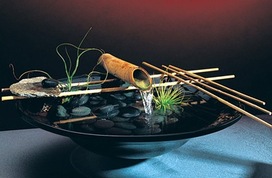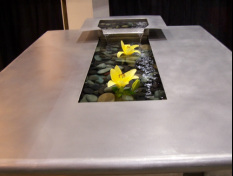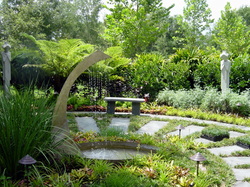Are you in the market for water feature designs? If so, Nayer Kazemi creates an extensive line of water fountains that can fit your custom needs. Nayer designs water walls, water fountains, and waterfalls using glass, stainless steel, copper, stone, acrylic, and many other materials. These custom designs can be displayed in a multitude of ways, whether indoor, outdoor, mounted, or as a tabletop. Nayer Kazemi’s skillful creations will add a new dimension to your life.
Once you have decided upon the water art that suits you best, you must decide what to do with this piece. Foremost, how do you want this water art to interact with you?
You may be thinking, “Interact? What interaction?” Well, this water art will now be a living entity as it flows, cascades, and creates a tranquil sound space as well as an aesthetic delight. Depending upon how you use it, this water art can interact with you in a number of different ways. When deciding where to place your newly acquired water art, you must account for the acoustics of the surrounding environment just as much as the aesthetics of the placement. While a certain placement location may look more attractive, you must remember that your new water fountain, water sculpture, water wall, or waterfall will entertain your ears as much as your eyes.
Once you have decided upon the water art that suits you best, you must decide what to do with this piece. Foremost, how do you want this water art to interact with you?
You may be thinking, “Interact? What interaction?” Well, this water art will now be a living entity as it flows, cascades, and creates a tranquil sound space as well as an aesthetic delight. Depending upon how you use it, this water art can interact with you in a number of different ways. When deciding where to place your newly acquired water art, you must account for the acoustics of the surrounding environment just as much as the aesthetics of the placement. While a certain placement location may look more attractive, you must remember that your new water fountain, water sculpture, water wall, or waterfall will entertain your ears as much as your eyes.

Different setups and acoustics will impact the sound of your water art. The height of the ceiling, the type of floor, and the openness of the space will each highlight different nuances of the sounds of your new purchase. You may have in mind the desired sound that you are looking for; however, it is always fun to tinker with the settings and test the acoustics.
If you have vaulted ceilings or just a nice high ceiling, the sound of the water will carry farther and provide a deeper resonance, filling the room with a nice background. If your ceiling is low, the rhythmic sounds of the piece will be less airy and distant, and more direct and in the forefront.
The next element to consider is the type of flooring. Carpeted floors will provide much different acoustics than wooden or tiled floors. Carpeted floors will trap the sound in, allowing less travel and reverb. Wooden and tiled floors will allow the sounds to bounce around and travel, filling a greater space.
The final element to consider is the actual openness of the space. If the room is busy or cluttered, the water feature sounds will stay more localized. The acoustics will have less room for expansion and will not carry as much. If the room is open and spacious, the acoustics will fill the entire room with rhythm and the sound will travel and carry throughout.
These acoustic variations can each give your water art a distinct sound that creates a totally unique ambience in its time and place.
One more thing to consider while tinkering with the sonic nature of your water art is the echo factor. If you place your fountain, sculpture, water wall, or waterfall in a room that contains high ceilings, wooden or tiled floors, and plenty of open space, your water art will produce full rhythmic sounds that will echo. This setup will produce a thorough soundscape and will enhance the rich potential of your purchase. Layers of sound will travel and echoes will be noticeable. However, if echoes bother you, you may be more inclined to place your water art in a busier area. A more closed or more furnished space will reduce the echo while still providing a local rhythm of soothing water cycles.
Ultimately, when evaluating sound factors, it is important to find what you personally enjoy. Let the water speak to you; let it interact with you and your space. Let it fill your eyes, ears, and mind with a delightful experience. Nayer Kazemi Water Art will provide you and your environment with distinct ambience and rhythmic peace. Enjoy.
--Timothy White
If you have vaulted ceilings or just a nice high ceiling, the sound of the water will carry farther and provide a deeper resonance, filling the room with a nice background. If your ceiling is low, the rhythmic sounds of the piece will be less airy and distant, and more direct and in the forefront.
The next element to consider is the type of flooring. Carpeted floors will provide much different acoustics than wooden or tiled floors. Carpeted floors will trap the sound in, allowing less travel and reverb. Wooden and tiled floors will allow the sounds to bounce around and travel, filling a greater space.
The final element to consider is the actual openness of the space. If the room is busy or cluttered, the water feature sounds will stay more localized. The acoustics will have less room for expansion and will not carry as much. If the room is open and spacious, the acoustics will fill the entire room with rhythm and the sound will travel and carry throughout.
These acoustic variations can each give your water art a distinct sound that creates a totally unique ambience in its time and place.
One more thing to consider while tinkering with the sonic nature of your water art is the echo factor. If you place your fountain, sculpture, water wall, or waterfall in a room that contains high ceilings, wooden or tiled floors, and plenty of open space, your water art will produce full rhythmic sounds that will echo. This setup will produce a thorough soundscape and will enhance the rich potential of your purchase. Layers of sound will travel and echoes will be noticeable. However, if echoes bother you, you may be more inclined to place your water art in a busier area. A more closed or more furnished space will reduce the echo while still providing a local rhythm of soothing water cycles.
Ultimately, when evaluating sound factors, it is important to find what you personally enjoy. Let the water speak to you; let it interact with you and your space. Let it fill your eyes, ears, and mind with a delightful experience. Nayer Kazemi Water Art will provide you and your environment with distinct ambience and rhythmic peace. Enjoy.
--Timothy White



 RSS Feed
RSS Feed
